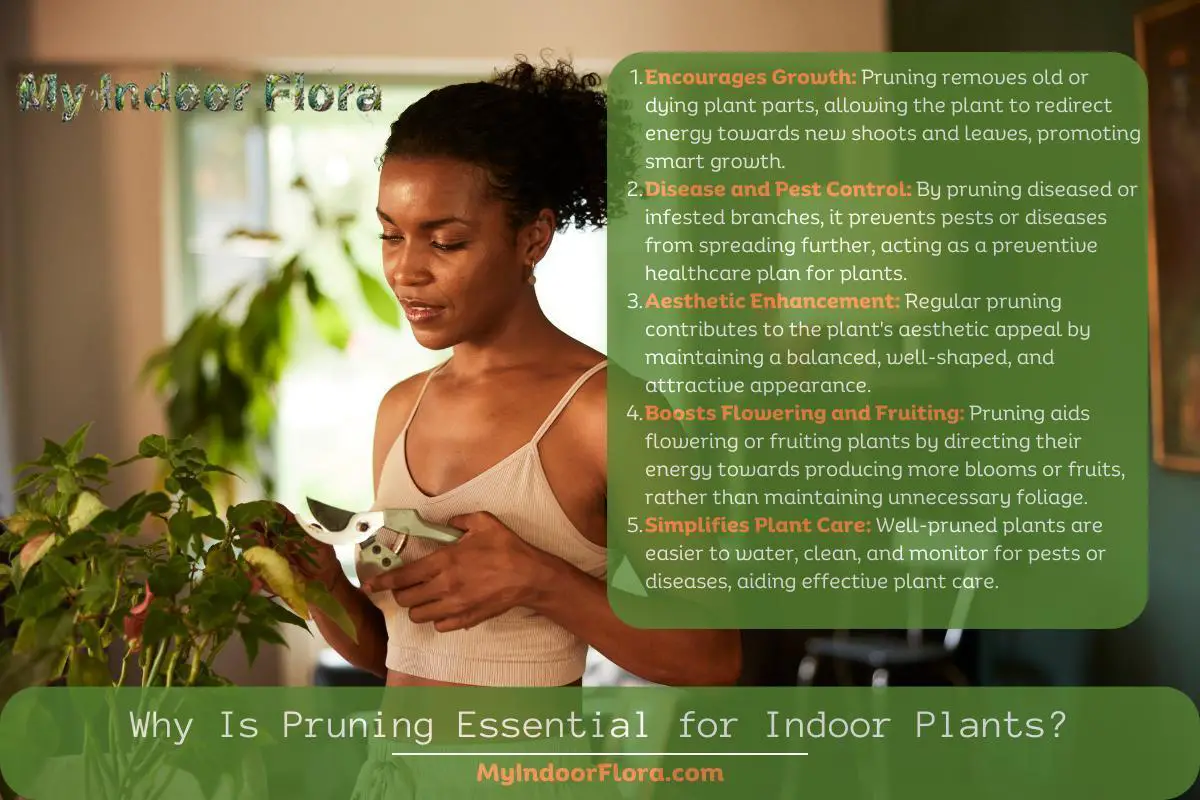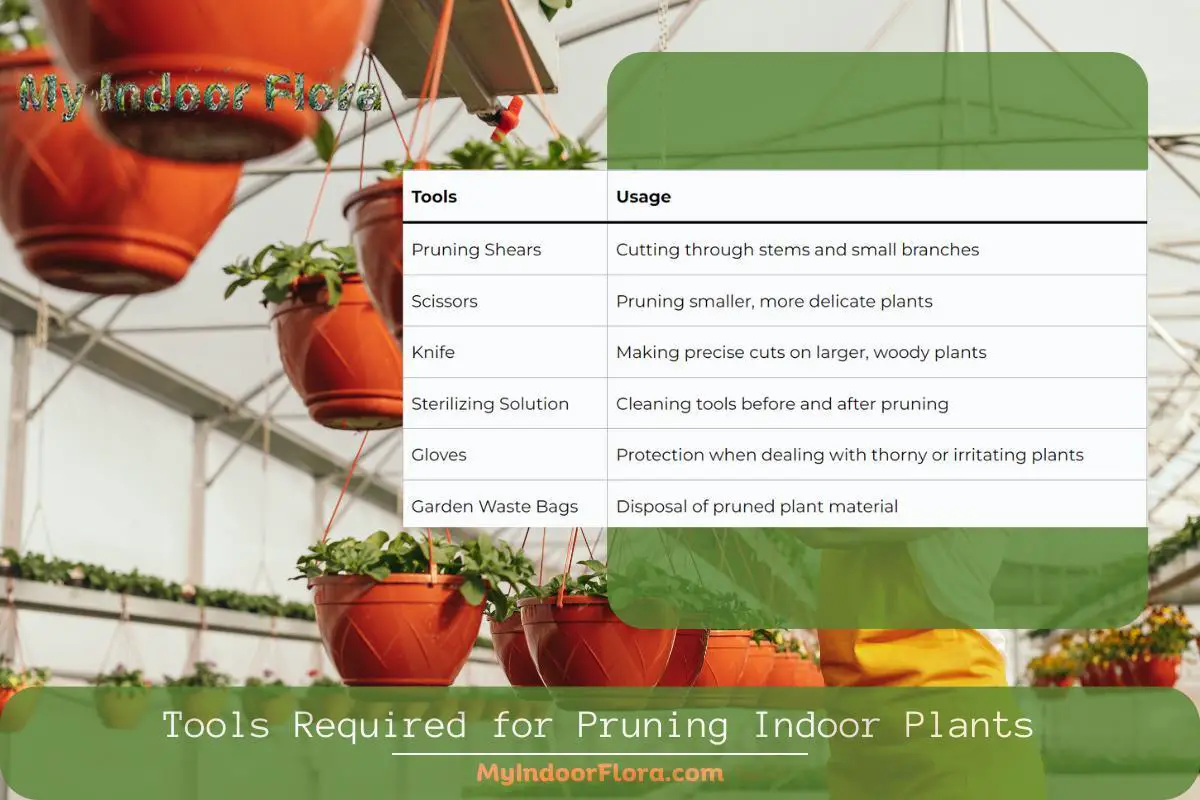Indoor plants are more than just decor; they’re living organisms that require care, attention, and above all, pruning. According to the Royal Horticultural Society, pruning, a horticultural practice that dates back to ancient times, is the selective removal of plant parts, typically shoots and branches, to improve or maintain plant health. Pruning is not merely a matter of aesthetics; it plays a pivotal role in plant growth by reducing disease spread, promoting airflow, and stimulating fresh growth.
So, how does one prune indoor plants for healthy growth? The answer lies in understanding the plant’s growth patterns, its needs, and the right techniques for pruning. Essentially, it is about removing dead, diseased, or overgrown branches or stems from your plant. This encourages stronger growth, better flower or fruit production, and a healthier overall plant.
In this comprehensive guide, we unravel the secrets of effective pruning. From understanding why pruning is crucial for your indoor plants to knowing when and how to prune, we have covered it all. We will walk you through the entire process, step-by-step, ensuring that by the end, you’ll be well-equipped to keep your indoor plants not just surviving, but thriving. Let’s get started on this journey towards healthier, happier indoor plants.
Why Is Pruning Essential for Indoor Plants?
Pruning, my dear readers, is so much more than a simple haircut for your plants. It’s a vital process that supports the overall well-being and longevity of your indoor greenery. In this section, we’ll break down the myriad reasons why pruning is absolutely non-negotiable when it comes to nurturing healthy indoor plants.

Promotes Healthy Growth
Did you know that by removing old or dying parts of your plant, you are actually encouraging new growth? Let me explain. Plants, like all living things, direct their energy to various growth activities. When a part of the plant starts to die off, the plant diverts resources towards trying to revive it. But if we remove these parts, the plant can redirect its energy towards developing new shoots and leaves. Now, that’s what I call working smart, not hard!
Helps in Pest and Disease Control
Pruning also plays a significant role in pest and disease control. Picture this: Your plant has a diseased or infested branch. Left untreated, the disease or pest could spread to the rest of the plant and potentially to other plants in your home. Pruning these affected parts nips this problem in the bud and prevents it from escalating. It’s like your plant’s personal healthcare plan!
Enhances Plant Aesthetics
Let’s not ignore the fact that pruning also contributes to the aesthetic appeal of your plants. Regular pruning helps maintain a balanced, well-shaped, and attractive plant. It’s like giving your plant a makeover – out with the old, in with the new!
Boosts Flowering and Fruiting
If you’ve got flowering or fruiting indoor plants, pruning can be a game-changer. By pruning, you’re helping the plant direct its energy and resources towards producing more flowers or fruits, rather than maintaining unnecessary foliage. The result? A plant that’s a blooming, fruiting wonder!
Facilitates Better Care
Lastly, a well-pruned plant is easier to care for. It’s easier to water, clean, and monitor for pests or diseases. It’s all about setting yourself up for success, folks!
Let’s add some numbers into the mix to help illustrate the benefits of pruning. Based on a study published in the Journal of the American Society for Horticultural Science, pruning can increase the total yield of certain plants by up to 30-40%!
When Is the Right Time to Prune Your Indoor Plants?
Timing, as they say, is everything – and this couldn’t be more true when it comes to pruning your indoor plants. Prune at the wrong time, and you could end up doing more harm than good. But fret not – I’m here to guide you through the process.
During Active Growth Periods
The golden rule of pruning is to do it during the plant’s active growth periods, which typically coincide with the warmer months. You see, plants are like us – they have their productive periods and their rest periods. Pruning during the active growth period allows the plant to heal quicker and put out new growth.
When Signs of Disease or Pests Appear
If you notice signs of disease or pests on your plant, it’s time to prune, irrespective of the time of year. Think of it as an emergency operation – it’s better to act quickly and prevent the issue from spreading.
At the Onset of Dormancy (For Some Species)
For some plant species, especially those that drop their leaves and enter a state of dormancy during winter, it’s best to prune just before this dormancy period begins. This way, the plant can focus on healing and come back stronger in the spring.
Post-Flowering (For Flowering Plants)
If you have flowering indoor plants, the best time to prune is after they’ve finished flowering. This gives the plant ample time to recover and gear up for the next flowering season.
Here’s a rough guide for some common indoor plants:
| Plant Type | Best Time to Prune |
|---|---|
| Ficus | Late Winter |
| Philodendron | Spring and Summer |
| Spider Plant | Spring |
| Pothos | Spring and Summer |
| Peace Lily | After Flowering |
| Jade Plant | Spring |
Remember, the timing for pruning can vary based on the specific needs of your plant species. Always do a bit of research or consult with a local horticulture expert to understand what’s best for your plant.

How to Identify Parts of the Plant that Require Pruning?
Identifying what parts of your indoor plants require pruning can sometimes feel like playing detective – looking for clues, identifying patterns, and making informed decisions. But don’t worry – I’ve got you covered with a comprehensive checklist to help you determine what needs to go and what can stay.
Look for Yellow or Brown Leaves
Yellow or brown leaves are often the first sign that your plant needs a trim. While a single yellow leaf might not be a cause for alarm, multiple yellow or brown leaves, particularly at the bottom of the plant, signal that it’s time to bring out the pruning shears.
Spot the Dead Ends
Dead ends, also known as “necrotic tips,” are a clear sign that pruning is required. These are typically characterized by browning and drying at the tips of the leaves. By removing these, you’re allowing the plant to redirect its energy towards healthier growth.
Identify Overgrown Areas
If parts of your plant are growing out of control and ruining the overall shape and balance of the plant, it’s time for a trim. Remember, pruning isn’t just about plant health – it’s also about maintaining the aesthetics!
Detect Signs of Disease or Pests
If you notice any spots, patches, or creepy-crawlies on your plant, these sections need to be pruned immediately. Pests and diseases can spread quickly, so early detection and action are key.
Check for Leggy Growth
‘Legginess’ in a plant refers to long, unbranched stems with sparse leaves – a sign that the plant isn’t getting enough light. Pruning these long stems encourages the plant to produce new, bushier growth that will help it absorb more light.
A tip from expert botanist Dr. Chris Martine is to inspect your plants regularly and touch them. According to him, regular inspection and physical contact help identify issues earlier and allow for timely pruning.
What Are the Tools Required for Pruning Indoor Plants?
Like any other task, having the right tools for pruning can make all the difference. So, let’s get down to business and look at the tools of the trade.
Pruning Shears
The most important tool in your pruning kit will undoubtedly be a good pair of pruning shears. They’re perfect for cutting through stems and small branches and come in various sizes to cater to different types of plants.
Scissors
For smaller, more delicate plants, a regular pair of sharp, clean scissors should do the trick. Make sure the blades are sharp to ensure clean, swift cuts that won’t damage the plant.
Knife
A sharp knife is also a handy tool to have in your pruning arsenal. It’s particularly useful for making clean, precise cuts on larger, woody plants.
Sterilizing Solution
Remember, hygiene is just as important in plant care as it is in human care! A sterilizing solution (you can use rubbing alcohol or a bleach solution) is a must-have to clean your tools before and after pruning. This prevents the spread of diseases and pests.
Gloves
While not necessary for all plants, gloves are a good idea if you’re dealing with thorny plants or plants with irritating sap.
Garden Waste Bags
Lastly, you’ll need some garden waste bags to dispose of the pruned plant material. This helps prevent any diseases or pests from spreading in your indoor garden.

According to a study published in Crop Protection, using clean, sterilized pruning tools can significantly reduce the spread of plant diseases. So, ensure your tools are as sharp and clean as your pruning skills!
Here is a simple table to summarize the main tools you need:
| Tools | Usage |
|---|---|
| Pruning Shears | Cutting through stems and small branches |
| Scissors | Pruning smaller, more delicate plants |
| Knife | Making precise cuts on larger, woody plants |
| Sterilizing Solution | Cleaning tools before and after pruning |
| Gloves | Protection when dealing with thorny or irritating plants |
| Garden Waste Bags | Disposal of pruned plant material |
How to Properly Prune Your Indoor Plants for Healthy Growth?
Now that we’ve got the why, when, and what of pruning covered, let’s get down to the ‘how.’ Pruning is more than just cutting off parts of the plant – it’s an art that requires a careful and thoughtful approach. So, without further ado, here’s your step-by-step guide to properly prune your indoor plants for healthy growth.

Step 1: Clean Your Tools
Before you start, ensure that your tools are clean and sharp. This is crucial to prevent the spread of diseases and ensure clean cuts. According to a study published in the journal “Plant Pathology”, using sterilized tools can reduce the transmission of certain plant diseases by up to 90%.
Step 2: Inspect Your Plant
Look over your plant carefully, identifying which parts need to be pruned. Remember the clues we discussed in the previous section – yellow or brown leaves, dead ends, overgrown areas, signs of disease or pests, and leggy growth.
Step 3: Make Your Cut
Once you’ve identified the parts that need to go, it’s time to make your cut. Do so at a 45-degree angle to promote quicker healing and reduce the chances of disease.
Step 4: Trim Gradually
It’s better to trim a little at a time than to cut off too much and regret it later. As the saying goes, “measure twice, cut once.”
Step 5: Monitor Your Plant
After pruning, keep a close eye on your plant. Make sure it’s getting the right amount of light and water, and look out for any signs of stress or disease.
Now let’s move on to what you should do with the pruned plant parts.
How to Manage the Pruned Plant Parts: Composting and Replanting?
So, you’ve finished pruning, and you’re left with a pile of plant parts. You might be tempted to just toss them into the trash, but hold on – these parts can still serve a purpose!
Composting
Composting is a great way to recycle pruned plant parts. By composting, you’re turning your green waste into a nutrient-rich soil conditioner that your plants will love.
- Start Your Compost Pile: Begin by layering brown material (like leaves, branches, or newspaper) and green material (your pruned plant parts) in a compost bin or pile.
- Turn Your Compost Regularly: This helps aerate the pile and speeds up the composting process.
- Use Your Compost: Once your compost looks and smells like dark, rich soil, it’s ready to use. Add it to your plant pots for a nutrient boost!
According to a study published in “Bioresource Technology,” compost can enhance soil fertility, improve plant growth, and reduce the need for chemical fertilizers.
Replanting
If the pruned parts are healthy, you might be able to use them to propagate new plants. Here’s a simple guide to replanting:
- Prepare Your Cutting: Remove any leaves from the bottom part of the cutting and apply a rooting hormone to encourage root growth.
- Plant Your Cutting: Plant the cutting in a pot with well-draining soil, making sure to keep the soil moist but not waterlogged.
- Wait for Roots to Grow: This might take a few weeks, so be patient. Once you see new growth, you’ll know that the cutting has successfully rooted.
Remember, not all plants can be propagated from cuttings, so do your research before you try this method!
In the words of Dr. Larry Hodgson, a renowned horticulturist, “One man’s trash is another man’s treasure.” So, the next time you prune your plants, think about how you can turn your ‘green waste’ into green gold!
What to Do After Pruning Your Indoor Plants?
Pruning your plants is just the beginning. To ensure that your indoor plants continue to thrive post-pruning, there are a few crucial steps that you need to follow. Let’s jump right in!
Keep Them Hydrated, But Don’t Overwater
Watering is crucial for recovery after pruning, but it’s also important not to overdo it. A common mistake people make is overwatering their plants after a significant trim. The logic seems sound: the plant has undergone stress, so it must need more water, right? Wrong. Overwatering can lead to root rot, which is just as damaging, if not more so, than under-watering. Monitor the plant’s needs and adjust accordingly.
Ensure Sufficient Light
Post-pruning, plants may require a bit more light than usual to aid recovery. Consider moving them to a location with better light conditions, but avoid placing them in direct sunlight, as this can cause leaf scorch.
Check for Pests and Diseases
After pruning, it’s a good idea to keep a close eye on your plant for any signs of pests or diseases. Pruning can leave your plant vulnerable, so checking regularly can ensure any potential issues are caught early.
Feed Them
Some plants may benefit from a little extra nutrition post-pruning. Consider using a balanced houseplant fertilizer to give your plants a boost and aid in recovery.
Dr. Lucy Bradley, an expert in Urban Horticulture, recommends waiting a few weeks post-pruning before fertilizing. This gives the plant time to recover from the initial stress of pruning.
How Frequently Should Indoor Plants be Pruned?
The frequency of pruning depends on a few factors, including the type of plant, its growth rate, and the conditions in which it’s growing. However, here are some general guidelines to help you figure out a pruning schedule for your indoor plants.
- Fast-Growing Plants: Fast-growing indoor plants, such as pothos or philodendrons, may need to be pruned every 4-6 weeks during the growing season to maintain their shape and size.
- Slow-Growing Plants: Slow-growing plants, such as snake plants or ZZ plants, require less frequent pruning. They may only need to be pruned once or twice a year.
- Flowering Plants: The pruning schedule for flowering plants depends on when they bloom. Spring-blooming plants should be pruned right after they finish flowering, while summer-blooming plants should be pruned in early spring.
Remember, pruning isn’t just about removing unhealthy or unwanted growth – it’s also a way to shape your plants and control their size.
What Are the Risks Associated with Over-Pruning?
Over-pruning, or removing too much of a plant at one time, can cause several issues.
Stunted Growth
Plants need leaves for photosynthesis, the process by which they create food for growth. Over-pruning can remove too many leaves, limiting the plant’s ability to photosynthesize and resulting in stunted growth.
Plant Stress
Just like us, plants get stressed too! Over-pruning can cause significant stress to plants, leaving them more susceptible to diseases and pests.
Poor Aesthetic Appeal
From an aesthetic point of view, over-pruned plants can look bare and unattractive. It can also lead to an unbalanced shape that takes a long time to correct.
Shock
In extreme cases, over-pruning can even cause plant shock, which can be fatal. The plant may not have enough stored energy to recover, leading to its eventual death.
The Royal Horticultural Society advises against removing more than one-third of a plant’s overall growth at a time. This allows the plant to have enough leaves left for photosynthesis and reduces the stress caused by pruning.
Remember, pruning should help your plants thrive, not cause them harm. So, always prune with care, and your indoor plants will thank you for it!
Conclusion: Keeping Your Indoor Plants Healthy and Happy
Pruning is an essential part of indoor plant care, providing an opportunity to shape your plants, encourage healthy growth, and prevent the spread of disease. But remember, like any art, pruning takes practice and patience.
Your plants might not look perfect straight after a prune, and that’s okay. With time, they will grow back stronger and healthier. After all, you’ve not just removed the old growth – you’ve made room for the new. You’ve not only taken away the weak – you’ve given strength to the rest. So, don’t be disheartened if your plant looks a little under the weather post-pruning; it’s just gearing up for a robust comeback!
As famed botanist Luther Burbank once said, “Flowers always make people better, happier, and more helpful; they are sunshine, food and medicine for the soul.” So, let’s keep our soul-nourishing companions healthy and thriving. Remember to prune wisely, follow the aftercare instructions, and most importantly, enjoy the process. Happy pruning!
